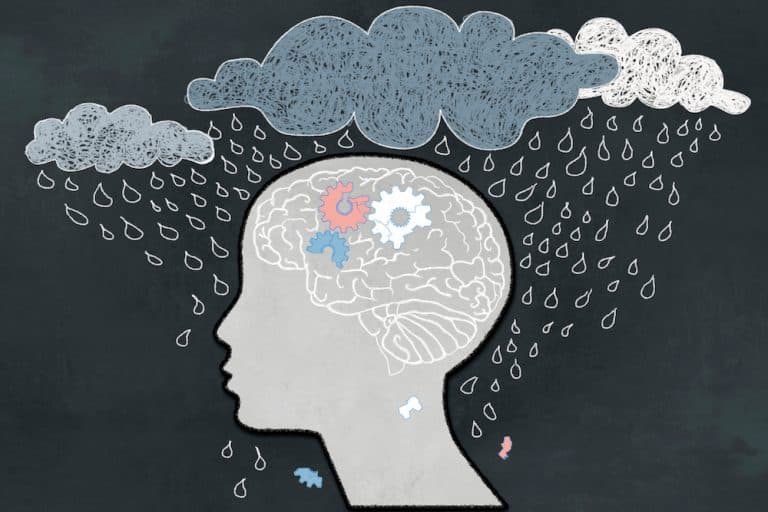Tokyo Mental Health is here to support you and provide you with the help you need.
Author: Shahroze Suzuki, TMH Psychologist
Depressive disorders are most commonly identified by symptoms such as low mood and loss of pleasure in daily activities. This is not to say that these are the only symptoms that are used to diagnose depressive disorders, but rather a point of reference that if the criteria are met, it is best to inquire for further symptoms that may help to identify which sub-classification of depressive disorder an individual might have.

What depressive disorders are there?
Below are some of the depressive disorders listed in DSM-5.
- Disruptive mood dysregulation disorder
- Major depressive disorder
- Persistent depressive disorder (dysthymia)
- Premenstrual dysphoric disorder
- Postpartum depression
What is the difference between sadness and depression itself?
Sadness and depression tend to be used interchangeably in common parlance but can be separated on the basis of these questions. Does it cause significant clinical distress? Does it bring about noticeable negative outcomes in aspects of life relating to career, socialisation, education, physical and important relationships? If so, then would you like to change how you feel?
What other symptoms occur in depressive disorders?
Depressive disorders are a combination of symptoms that include other signs apart from sadness and anhedonia. Below is a collection of symptoms that are expressed in different kinds of depressive disorders.
- Fatigue, tiredness, low energy
- Loss of pleasure in daily activities.
- Lack of motivation to take initiatives or carry out daily activities.
- Social withdrawal
- Thoughts about death and suicidal ideation
- Suicide attempts
- inability to maintain focus or concentrate.
- inability to make decisions.
- Insomnia or hypersomnia, sleep disturbance
- Decreased appetite that may result in 5% weight loss
- Increased appetite
- Feelings of worthlessness
- Easily distracted
- Poor memory, inability to recall previously easily remembered information,
- Repeated negative thoughts
- Somatic complaints such as body pain and headaches
- Anxiety and restlessness
- Low self- esteem
- Crankiness / irritability
- Guilt
- Hopelessness
- Digestive problems
Are there other disorders that can occur with depressive disorders?
Depressive disorders have been found to frequently accompany other mental health conditions. Doctors call this issue comorbidity. According to the DSM-5, the disorders that most frequently co occur with depressive disorders include anxiety disorders such as generalized anxiety disorder and panic disorder, eating disorders such as anorexia nervosa and bulimia nervosa, and personality disorders such as borderline personality disorder.
For example, according to a 2015 study that spanned 24 countries, 46% of individuals with a lifetime major depressive disorder had a lifetime history of one or more anxiety disorders. To add to this, another paper reported lifetime comorbidity with depression to range from 20% to 70% for patients with social anxiety disorder, 50% for patients with panic disorder, 48% for patients with post traumatic stress disorder (PTSD), and 43% for patients with generalized anxiety disorder. For obsessive compulsive disorder, it was reported that one-third of individuals in a 2002 study had experienced at least one episode of major depression, and a more recent study in 2010, using a larger sample size, reported lifetime prevalence rates for major depression to be 68%. According to a 2009 study, the prevalence rate for depressive disorders for those with eating disorders ranged from 36% to 86%. According to a 2012 paper, this means many people who have BPD also experience problems with depression. One study found that about 96% of patients with BPD met criteria for a mood disorder. In this study, about 83% of patients with BPD also met criteria for major depressive disorder, and about 39% of patients with BPD also met criteria for dysthymic disorder.
References
- Kessler RC, Sampson NA, Berglund P, et al.: Anxious and non-anxious major depressive disorder in the World Health Organization World Mental Health Surveys. Epidemiol Psychiatr Sci 2015; 24:210–226 Crossref, Medline, Google Scholar
- Dunner DL: Management of anxiety disorders: the added challenge of comorbidity. Depress Anxiety 2001; 13:57–71 Crossref, Medline, Google Scholar
- Beatson JA, Rao S. Depression and borderline personality disorder. Med J Aust. 2012;1(4):24-27. doi:10.5694/mjao12.10474
- Kessler RC, Sonnega A, Bromet E, et al.: Posttraumatic stress disorder in the National Comorbidity Survey. Arch Gen Psychiatry 1995; 52:1048–1060 Crossref, Medline, Google Scholar
- Green MA, Scott NA, Cross SE, Liao KYH, Hallengren JJ, Davids CM, Carter LP, Kugler DW, Read KE, Jepson AJ: Eating disorder behaviors and depression: a minimal relationship beyond social comparison, self‒esteem, and body dissatisfaction. J Clin Psychol. 2009, 65 (9): 989-999. 10.1002/jclp.20586.
- Quarantini, L. C., Torres, A. R., Sampaio, A. S., Fossaluza, V., Mathis, M. A., do Rosário, M. C., Fontenelle, L. F., Ferrão, Y. A., Cordioli, A. V., Petribu, K., Hounie, A. G., Miguel, E. C., Shavitt, R. G., & Koenen, K. C. (2011). Comorbid major depression in obsessive-compulsive disorder patients. Comprehensive psychiatry, 52(4), 386–393. https://doi.org/10.1016/j.comppsych.2010.09.006
- Overbeek, T., Schruers, K., Vermetten, E., & Griez, E. (2002). Comorbidity of obsessive-compulsive disorder and depression: prevalence, symptom severity, and treatment effect. The Journal of clinical psychiatry, 63(12), 1106–1112. https://doi.org/10.4088/jcp.v63n1204